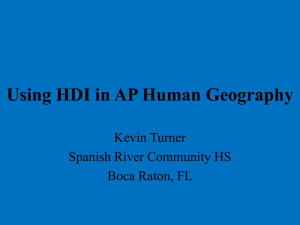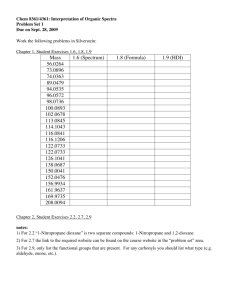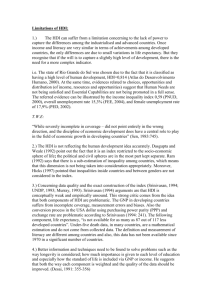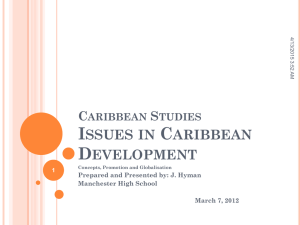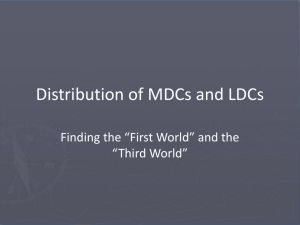Trade and Human Development in OIC Countries: A Panel Data
advertisement
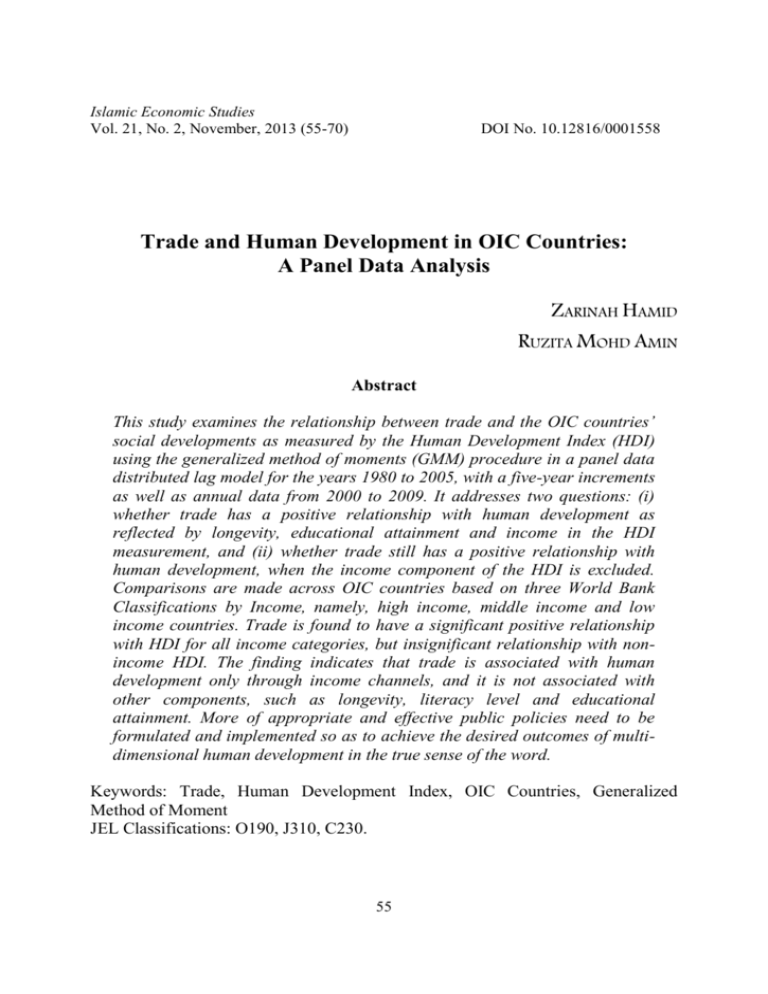
Islamic Economic Studies Vol. 21, No. 2, November, 2013 (55-70) DOI No. 10.12816/0001558 Trade and Human Development in OIC Countries: A Panel Data Analysis ZARINAH HAMID RUZITA MOHD AMIN Abstract This study examines the relationship between trade and the OIC countries’ social developments as measured by the Human Development Index (HDI) using the generalized method of moments (GMM) procedure in a panel data distributed lag model for the years 1980 to 2005, with a five-year increments as well as annual data from 2000 to 2009. It addresses two questions: (i) whether trade has a positive relationship with human development as reflected by longevity, educational attainment and income in the HDI measurement, and (ii) whether trade still has a positive relationship with human development, when the income component of the HDI is excluded. Comparisons are made across OIC countries based on three World Bank Classifications by Income, namely, high income, middle income and low income countries. Trade is found to have a significant positive relationship with HDI for all income categories, but insignificant relationship with nonincome HDI. The finding indicates that trade is associated with human development only through income channels, and it is not associated with other components, such as longevity, literacy level and educational attainment. More of appropriate and effective public policies need to be formulated and implemented so as to achieve the desired outcomes of multidimensional human development in the true sense of the word. Keywords: Trade, Human Development Index, OIC Countries, Generalized Method of Moment JEL Classifications: O190, J310, C230. 55 56 Islamic Economic Studies Vol. 21, No.2 1. Introduction The increasingly globalized world has made countries’ engagement with international markets not just unavoidable but also beneficial since trade can facilitate, promote and sustain the development process. For individual nations, trade is seen as a prerequisite for sustained growth. This is currently the dominant view—an inherent extension of the arguments on the classic theoretical exposition of the gains from trade. The United Nations Development Program (UNDP) in its Asia Pacific Human Development Report 2006 presented a conceptual framework that relates trade to human development. The framework says that trade has been known to have the ability to change the structure of the economy as well as the rate of growth. This, in turn, has implications for employment of factors of production, particularly both labor and capital. Trade has been said to reward skilled labor more highly than unskilled labor and can lead to the adoption of capital-intensive technologies that may deepen inequality. However, such a problem can be prevented through public policies that can be used to ensure that trade benefits human development. There is also a feedback loop from human development to trade, which operates directly or is mediated through the domestic policy framework. Feedback effects work through higher income, higher technical competence and skills or through the power of advocacy on policymakers. Finally, human development can also have a direct influence upon the structure of the economy, the rate of growth and trade itself (UNDP, 2006). The links between trade and human development can be summarized in Figure 1. There are three basic building blocks in the diagram: trade, human development and the links between the two. The hypothesized chain is: trade → growth → human development → trade. There is thus a two-way causation: from trade to human development and back to trade. Even though traditional trade models have shown that trade liberalization and expansion will generate high income and economic growth (López, 2005), its translation into corresponding improvements in human development is not automatic. It depends on how and the extent to which the pattern and character of economic growth affect specific dimensions of human development. Trade should not be an end in itself. Rather, it should realize a broad range of human Zarinah & Ruzita: Trade and Human Development in OIC Countries 57 development objectives, and especially to help alleviate poverty and reduce human deprivation in the poorest and Least Developed Countries (LDCs) (UNDP, 2006).1 Figure 1 Trade and Human Development – A Schematic View Source: Figure 1.1 of UNDP (2006), p. 16. Trade and private investment are needed to provide new engines of growth and dynamism for most developing countries. With more trade and investment, the countries will be able to achieve faster growth, reduce poverty, create more jobs, and improve the knowledge, skills, and productivity of their workforce. While most developing countries have managed to achieve improvements in trade and private 1 In order to translate trade liberalization into improvements in human development, various institutional factors must be in place such as political stability, political will and an established regulatory framework. 58 Islamic Economic Studies Vol. 21, No.2 investments in the 1990s, the Middle East and North Africa (MENA)2 was the only region in the world to experience a reversal (World Bank, 2003). Poverty did not improve in the last decade, but human development indicators for the region are reported to have improved tremendously, at a rate that surpassed even that of lower middle income countries (Iqbal, 2006). The experience of the MENA countries as stated above, the majority of which are OIC countries, presents a paradox to the earlier argument that trade has a positive impact on human development. Hence, it is a cause for further analysis. The UNDP model is adopted in this study since it is, by far, the most comprehensive model that provides the distinct link between trade and human development. Since the objective of this study is not to examine the directions of causality, it will focus only on the first relationship, i.e., from trade to human development through higher growth rates. Thus, the question addressed by this study is: does trade have a positive relationship with human development (as a measure of social development)? Since human development is commonly measured by the Human Development Index (HDI) which consists of three components, namely, longevity, educational attainment and income, another question addressed in this study is: does the positive relationship between trade and social development still hold if the income component of the HDI is excluded? The analysis in this study involves making comparisons of the results across three categories of OIC countries according to the World Bank Classifications by Income, namely: (i) High income countries (Bahrain, Brunei, Kuwait, Qatar, Saudi Arabia and United Arab Emirates); (ii) Middle income (both upper and lower middle income) countries (Albania, Algeria, Gabon, Iran, Kazakhstan, Malaysia, Turkey, Cameroon, Cote d’Ivoire, Egypt, Guyana, Indonesia, Jordan, Maldives, Morocco, Pakistan, Senegal, Sudan, Tunisia and Yemen); and (iii) Low income countries (Bangladesh, Chad, Gambia, Kyrgyzstan, Mali, Mauritania, Mozambique, Niger, Sierra Leone, Tajikistan, Togo and Uganda). Such a comparison is necessary to examine whether there is a positive relationship between trade and HDI across the three classifications of OIC countries. 2 Based on the World bank classification, the Middle East and North Africa (MENA) region is comprised of twenty-one countries or territories, namely, namely the Gulf Cooperation Council (GCC) members (Bahrain, Kuwait, Oman, Qatar, Saudi Arabia, and United Arab Emirates), and fifteen other countries or territories, i.e., Algeria, Djibouti, the Arab Republic of Egypt, Iraq, the Islamic Republic of Iran, Israel, Jordan, Lebanon, Libya, Malta, Morocco, the Republic of Yemen, the Syrian Arab Republic, Tunisia, and the West Bank and Gaza (World Bank, 2003). Zarinah & Ruzita: Trade and Human Development in OIC Countries 59 This paper is structured as follows. The next section provides a brief survey of the literature on trade and human development both at the inter-country as well as intra-country analyses. Section 3 describes the data and methodology used in this study. Section 4 presents the analysis and discussion of the findings while the last section concludes. 2. Literature Review There is an extensive literature on the impact of trade on social well-being (with economic growth explicitly included in some studies), both at the cross-country as well as within-country analyses. Various aspects of social well-being have been examined and the most important ones include income inequality, poverty, and human development as a composite index. A review of the vast literature using cross-country comparisons for the impact of trade openness on poverty within countries can be found in Ravallion (2006). He highlights a number of studies that have combined survey-based measures of income inequality at country level with data on trade and other control variables to assess the distributional impacts of trade openness; the latter is typically measured by “trade volume,” defined by exports plus imports as a share of GDP (examples include Bourguignon and Morisson (1990), Edwards (1997), Li, Squire, and Zou (1998), Barro (2000), Dollar and Kraay (2002, 2004), Lundberg and Squire (2003), and Milanovic (2005)). The results are mixed which implies ambiguous implications of trade on inequality. In an influential study by Dollar and Kraay (2002, 2004), they find little or no effect of trade volume on inequality, contrary to the findings of other studies which reported adverse effects on inequality. Lundberg and Squire (2003), for instance, find evidence that higher trade volume tends to increase inequality. Some studies also report similar findings in the case of poor countries but the reverse holds at higher mean income (Milanovic, 2005; Ravallion, 2001). The implications for poverty also depend on the growth impacts. Dollar (1992), Sachs and Warner (1995), Harrison (1996), and Edwards (1998), among others, provide empirical support for the view that trade expansion promotes economic growth. In a meta-study of all the cross-country growth regressions with an average of seven regressors (chosen from 67 candidates drawn from the literature on crosscountry growth regressions), Sala-I-Martin, Doppelhofer, and Miller (2004) report that trade volume is significant in two-thirds of the regressions, though it is not among their subset of 18 robust predictors of economic growth. Whether the 60 Islamic Economic Studies Vol. 21, No.2 growth effects are strong enough such that poverty falls with trade openness remains unclear. The findings of Dollar and Kraay (2004) and others that trade does not affect inequality but fosters growth make it very likely that it lowers absolute poverty (meaning that the poverty line is fixed in real terms). In a study on China, Ravallion (2006) tests the claim that the country’s greater trade openness has been an important factor in reducing poverty. Aggregate time series data spanning the period 1980–2000 and three poverty measures were used, namely, the headcount index, the poverty gap index, and the squared poverty gap index. For all 3 poverty measures, no significant effect is found of current or lagged trade volume on poverty in China, a finding which is significantly different from earlier studies. Very few works have attempted to look at the relationship between trade and human development as a whole. Arimah (2002) relates inter-country variations in the level of human development to inter-country differences in the macroeconomic environment, investment in human capabilities, good governance, commitment to the objectives of human development, and natural resource endowment. The study finds that the macroeconomic environment is the key determinant of inter-country differences in human development. Specifically, economic growth has a positive impact on human development. In another study, Davies and Quinlivan, (2006) examines the impact of trade on countries’ social developments as measured by the Human Development Index (HDI). The generalized method of moments (GMM) procedure in a panel data distributed lag model is used and the change in the HDI index is modeled as a function of per-capita trade. Using panel data on 154 countries for the period 1975 – 2002, the study finds that increases in trade are positively associated with future increases in social welfare. Gunduz, Hisarciklilar and Kaya (2009) find similar results in terms of the positive relationship between trade and social development for the different classifications of 106 countries from 1975-2005. The study also reveals that this positive link is valid only for high and upper middle income countries, but diminishes with lower income when the income component of the HDI is excluded. The survey of literature above has shown that very few studies have looked into the relationship between trade and human development, particularly whether there are cross-country variations in the different categories of income levels of OIC countries. Hence, this study is an attempt to fill this gap. Zarinah & Ruzita: Trade and Human Development in OIC Countries 61 3. Methodology and Data Description This study utilizes panel data estimation technique following Gunduz, Hisarciklilar and Kaya (2009) and Davies and Quinlivan (2006) with the model: HDIi ,t 1HDIi ,t 1 2Tradei ,t i i ,t where HDIi ,t Human Development Index for countryi periodt exp ortsi ,t importsi ,t Tradei ,t ln populationi ,t (1) exp ortsi ,t 1 importsi ,t 1 ln populationi ,t 1 i is thefixed or random effect which measures thespecific characteristics of countryi i ,t disturbances The Generalized Method of Moments (GMM) technique is applied on this model since it is a very general statistical method of formulating models and obtaining estimates of parameters without making strong assumptions on their distributions. The idea of the GMM is to use moment conditions that can be found from the problem with little effort. It is a method of estimating the population parameters such as mean, variance, and median, by equating sample moments with unobservable population moments and then solving those equations for the quantities to be estimated. According to Greene (2003), the GMM estimators are assumed to converge and meet the conditions of law of large numbers, they fulfill the identification conditions and they are asymptotically distributed. Irwin and Tervio (2002) and Noguer and Siscart (2005) used the Ordinary Least Square (OLS) method to determine if trade raises income. However, the GMM method is preferred to the OLS method because the former is applicable when estimating an unknown probability distribution whereas the latter always assumed that the error term is normally distributed. Furthermore, the OLS estimation is very sensitive to outliers and with the existence of outliers in the data it will lead to biased and inefficient estimates. In other words, the OLS method is notoriously non-robust to outliers. Since we anticipate that our study will contain such category of dataset and the appropriate probability distributions may not be known, hence the moment-based estimates are preferred to OLS estimates. 62 Islamic Economic Studies Vol. 21, No.2 Using the standard procedure in GMM estimation by taking the first difference of the variables in a distributed-lag model, equation (1) becomes: (2) HDIi ,t 1HDIi ,t 1 2 Tradei ,t i ,t where HDIi HDIi ,t HDIi ,t 1 Tradei ,t Tradei ,t - Tradei ,t 1 i ,t i ,t i ,t 1 The next stage is to determine the appropriate lag length by using the ArellanoBond estimator and then used the lagged values of the dependent variable ( HDI i ,t 2 j , j 0,1... ) as an instrument for the HDI i while deriving the moment conditions (Gunduz, Hisarciklilar and Kaya, 2009). It is assumed that the disturbances are homoscedastic within countries and over time, (possibly) heteroscedastic across countries and otherwise well behaved,i.e., 2 i j , t v cov(i ,t , j ,v ) i 0 otherwise In order to examine the impact of trade on social development (i.e., HDI excluding the income component), another model is also estimated utilizing HDI* defined as non-income HDI: HDIi*,t 1HDIi*,t 1 2 Tradei ,t i ,t (3) where 1 log( y ) log( y min ) , HDIi*,t HDIi ,t max min 3 log( y ) log( y ) y = Gross national income per capita, y min = PPP US$100, y max = PPP US$40,0003 HDIi*,t HDIi*,t HDIi*,t 1 Tradei ,t Tradei ,t - Tradei ,t 1 i ,t i ,t i ,t 1 3 The definition is based on the official formula at http:// hdr.undp.org/en/statistics/data/calculator/. The HDI is computed as a simple average of the three components of life expectancy, education and standard of living, where HDI = 1/3(life expectancy index)+1/3(education index)+1/3(GDP index). Hence, subtracting the third component, i.e., the income component from the HDI, results in the nonincome HDI, namely HDI*. Zarinah & Ruzita: Trade and Human Development in OIC Countries 63 This study uses secondary data from several sources namely the World Bank, the United Nations Development Programme (UNDP) Publications, International Financial Statistics CD-ROM, Direction of Trade Statistics (various years) and IMF World Economic Outlook Database. The HDI data are retrieved from the UNDP publications as a measure of social development while the other data sources supply the information to compute the country’s per-capita trade. Data for HDI are reported in 5-year increments beginning 1975 until 2010. However, the year 1975 is excluded since the HDI data are not reported for Bahrain and Jordan while the year 2010 is excluded because four countries, namely Oman, Lebanon, Iraq and Somalia are yet to furnish their Human Development Index to the UNDP. In addition, several OIC countries in the high, middle and low income categories are excluded from the study due to data constraint. Table 1 summarizes the number of countries included in the study by income classifications containing HDI data of 5-year increments and yearly increments. Table 1 Number of Countries by Income Classifications High income countries Middle income (both upper and lower income) Low income countries Total Number of countries % of sample Yearly (2000-2009) % of sample 12.5 6 15.8 15 62.5 20 52.6 6 25.0 12 31.6 24 100 38 100 5-year increments (1980-2005) 3 Based on availability of HDI data for the five-year increments, this study makes a comparison of the results across the following categories of 24 OIC countries as in World Bank (2007), namely: (i) High income countries (Bahrain, Saudi Arabia and United Arab Emirates); (ii) Upper middle and lower middle income countries (Algeria, Gabon, Malaysia, Turkey, Cameroon, Cote d’Ivoire, Egypt, Guyana, Indonesia, Jordan, Morocco, Pakistan, Senegal, Sudan and Tunisia); and (iii) Low income countries (Bangladesh, Mali, Mozambique, Niger, Sierra Leone and Togo). As shown in Table 1, HDI data for a total of 24 countries are available at five-year increments. Starting from the year 2000, HDI was reported on annual basis and 64 Islamic Economic Studies Vol. 21, No.2 with the availability of this annual data the number of countries in each classification increases to six for High income countries (Bahrain, Brunei, Kuwait, Qatar, Saudi Arabia and United Arab Emirates); 20 for Upper middle and lower middle income countries (Albania, Algeria, Gabon, Iran, Kazakhstan, Malaysia, Turkey, Cameroon, Cote d’Ivoire, Egypt, Guyana, Indonesia, Jordan, Maldives, Morocco, Pakistan, Senegal, Sudan, Tunisia and Yemen); and 12 for Low income countries (Bangladesh, Chad, Gambia, Kyrgyzstan, Mali, Mauritania, Mozambique, Niger, Sierra Leone, Tajikistan, Togo and Uganda). Therefore, for HDI data series produced annually from 2000 to 2009, a total of 38 are utilized in this study (see Table 1). 4. Analysis and Discussion The trends in HDI and total trade over the period of analysis by income classifications are provided in Figures 2 and 3. The average HDI and the average total trade are highest for high income countries, followed by middle and low income countries. The average HDI shows an increasing trend over the years for all countries. The average total trade of high income countries increased rapidly beginning 2002, peaked in 2008 and declined in 2009. However, the average total trade of middle and low income countries remained almost the same throughout the period of analysis. Figure 2 Average HDI for OIC Countries Based on Income Classifications Zarinah & Ruzita: Trade and Human Development in OIC Countries 65 Figure 3 Average Total Trade for OIC Countries Based on Income Classifications Two sets of estimations are performed separately for each of the three income classifications of OIC countries,4 choosing the dependent variables as HDIi ,t to examine the impact of trade on human development as a whole, and on HDIi*,t to investigate further the impact of trade on actual social development, when income is excluded from HDI. The estimations utilizing five-year increments of HDI generally yields insignificant results for all variables across all income classifications. This may be due to the relatively small number of observations obtained for each income classifications due to data constraints. Hence, the results are not reported.5 The first estimation on yearly data from 2000 to 2009, however, yields more interesting results. Trade per capita (Tradei) is positively correlated with the variation of the HDI and found to be significant (see Table 2). A similar result is found in Davies and Quinlivan (2006) where trade and social welfare is significant and positively related. However, only for the low income countries, increases in HDI levels observed over the past two years (HDIi,t-1) have a positive relationship with the changes in total human development over the past period. 4 The estimation using the 5-year increments is also performed in addition to using yearly data in order to capture the experience of the countries in the years prior to 2000, of which data on HDI is reported only on a 5-year intervals. 5 The estimation results are available upon request. 66 Islamic Economic Studies Vol. 21, No.2 Table 2 Estimation Results for Model 1 (HDI) High Income OIC Middle Income OIC Low Income OIC 0.015945* 0.031975** 0.028499* (1.730908) (1.311648) (1.826700) 0.124217 0.656232 0.842536* HDIi,t-1 (0.347137) (1.986531) (1.707403) Constant 0.001783 -0.001802 -0.003014 (0.2713) (-0.726927) (-0.676971) J-statistic 3.25E-28 1.04E-27 4.79E-27 Notes: *, **, *** denote significance at the 10%, 5%, and 1% level, respectively. Figures in parentheses are t-statistics. Tradei Table 3 Estimation Results for Model 2 (HDI*) High Income OIC Middle Income OIC Low Income OIC 0.015754 0.016988 0.005793 (0.919449) (0.987545) (1.351529) 0.259937 0.426475 0.756557*** HDIi*,t 1 (0.434948) (1.273604) (4.432921) Constant 0.000452 0.000421 -2.31E-05 (0.377653) (0.389446) (-0.030823) J-statistic 4.21E-30 2.60E-27 1.81E-27 Notes: *, **, *** denote significance at the 10%, 5%, and 1% level, respectively. Figures in parentheses are t-statistics. Tradei The second estimation on HDIi*,t that excludes the income component of HDI shows non-significance of the trade variable for all income classifications (see Table 3). This indicates that trade relates positively only with the income component of human development, but not with the other components, such as longevity, literacy level and educational attainment as captured by HDIi*,t . Thus, consistent with Gunduz, Hisarciklilar and Kaya (2009), trade is found to be linked to human development only through income channels. As before, only for the low income countries, increases in HDI levels observed over the past two years ( HDIi*,t 1 ) have a positive relationship with the changes in total human development over the past period. This suggests that for the middle and high income OIC countries, the level of development has reached a level where the Zarinah & Ruzita: Trade and Human Development in OIC Countries 67 growth in human development over the period has become small, rendering it insignificant. Examining the validity of both models, the J-statistic null hypothesis states that a model is valid while the alternative hypothesis indicates that a model is invalid and the data do not come close to meeting the restrictions. The results in Table 2 indicate that the null hypothesis cannot be rejected at the 99% confidence level (or at the 1% significance level), thus both the models are, overall, valid. 5. Conclusion and Policy Recommendation Trade has been known to have the ability to change the structure of the economy as well as the rate of growth. It is a means to realize a broad range of human development objectives, such as to help alleviate poverty and reduce human deprivation. This study examines the relationship between trade and the OIC countries’ social developments as measured by the HDI using the GMM procedure in a panel data distributed lag model for the years 1980 to 2005, with a five-year increments as well as annual data from 2000 to 2009. It addresses two questions: (i) does trade have a positive relationship with human development as reflected by longevity, educational attainment and income in the HDI measurement? (ii) If the positive relationship between trade and human development exists, does it still hold if the income component of the HDI is excluded? Comparisons are made across OIC countries based on three World Bank Classifications by Income, namely, high income, middle income and low income countries. The study finds that trade is positively linked to HDI for all income categories, but the link is insignificant on non-income HDI. The finding indicates that trade relates to human development only through income channels, and it does not relate to other components, such as longevity, literacy level and educational attainment. The study also found that increases in HDI levels observed over the past two years have a positive relationship with the changes in total human development over the past period only for the low income countries. This suggests that for the middle and high income OIC countries, the level of development has reached a level where the growth in human development over the period has become less gradual, rendering it insignificant. As mentioned in the beginning of this paper, even though trade liberalization and expansion can generate high income and economic growth, its translation into 68 Islamic Economic Studies Vol. 21, No.2 corresponding improvements in human development is not automatic. It depends on how and the extent to which the pattern and character of economic growth affect specific dimensions of human development, and this can be greatly influenced by appropriate public policies that can be used to ensure that trade benefits human development. The finding that trade no longer has a positive relationship with human development when the income component is excluded may imply that public policies in these countries have been unable to channel the benefits from trade into more meaningful dimensions of human development. Hence, more of appropriate and effective public policies need to be formulated and implemented so as to achieve the desired outcomes of multi-dimensional human development in the true sense of the word. References Arimah, B. C. (2002), “Nature, determinants and prospects for sustainable human development in the Arab region,” in Arab Development Challenges of the New Millennium, edited by Belkacem Laabas, Hampshire, England: Ashgate Publishing Limited. Barro, R. (2000), “Inequality and growth in a panel of countries.” Journal of Economic Growth 5: 5–32. Bourguignon, F., and Morisson, C. (1990), “Income distribution, development and foreign trade.” European Economic Review 34: 1113–1132. Davies, A., & Quinlivan, G. (2006) , “A panel data analysis of the impact of trade on human development.” The Journal of Socio-Economics 35: 868–876. Dollar, D. (1992), “Outward-oriented developing economies really do grow more rapidly: Evidence from 95 LDCs, 1976–1985.” Economic Development and Cultural Change 40(3): 523–544. Dollar, D. and Kraay, A. (2002), “Growth is good for the poor.” Journal of Economic Growth 7(3): 195–225. Dollar, D. and Kraay, A. (2004), “Trade, growth and poverty.” Economic Journal 114(493): F22–F49. Edwards, S. (1997), “Trade policy, growth and income distribution.” American Economic Review 87(2): 205–210. Edwards, S. (1998), “Openness, productivity and growth: What do we really know?” Economic Journal 108: 383–398. Zarinah & Ruzita: Trade and Human Development in OIC Countries 69 Gunduz, U., Hisarciklilar, M., and Kaya, T. (2009), “The Impact of Trade on Social Development.” World Academy of Science, Engineering and Technology: 1648-1651. Greene, W.H. (2003), Econometric Analysis. Fifth Edition, New Jersey, U.S.A: Prentice-Hall. Harrison, A. (1996), “Openness and growth: A time series, cross-country analysis for developing countries” Journal of Development Economics 48(2): 419–447. Iqbal, F. (2006), Sustaining Gains in Poverty Reduction and Human Development in the Middle East and North Africa, Washington D.C.: The International Bank for Reconstruction and Development/The World Bank. Irwin, D.A., and Tervio, M. (2002), “Does trade raise income? Evidence from the twentieth century” Journal of International Economics 58: 1-18. Li, H., Squire, L., & Zou, H. (1998), “Explaining international and intertemporal variations in income inequality.” Economic Journal 108: 26–43. López, R.A. (2005), “Trade and growth: reconciling the macroeconomic and microeconomic evidence.” Journal of Economic Surveys 19(4): 623-648. Lundberg, M., and Squire, L. (2003), “The simultaneous evolution of growth and inequality.” Economic Journal 113: 326–344. Milanovic, B. (2003), “Can we discern the effect of globalization on income distribution?” World Bank Economic Review 19(1): 21–44. Noguer, M., and Siscart, M. (2005), “Trade increases income: A precise and robust result.” Journal of International Economics 65: 447-460. Ravallion, M. (2001), “Growth, inequality and poverty: Looking beyond averages.” World Development 29(11): 1803–1815. Ravallion, M. (2006), “Looking beyond averages in the trade and poverty debate.” World Development 34(8): 1374–1392. Sachs, J., and Warner, A. (1995), “Economic convergence and economic policies.” Brookings Papers on Economic Activity 1: 1–95. Sala-I-Martin, X., Doppelhofer, G., and Miller, R. (2004), “Determinants of longterm growth: A Bayesian averaging of classical estimates (BACE) approach.” American Economic Review 94(4): 813–836. UNDP. (2006), Asia Pacific Human Development Report 2006: Trade on Human Terms- Transforming Trade for Human Development in Asia and the Pacific. United Nations Development Program. 70 Islamic Economic Studies Vol. 21, No.2 World Bank. (2003), Trade, Investment, and Development in the Middle East and North Africa: Engaging with the World. Washington, D.C.: The International Bank for Reconstruction and Development/The World Bank.


